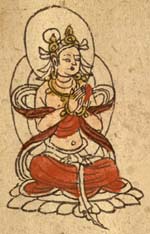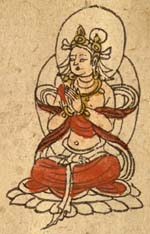
The Doctrines
of Buddhism


|
The Doctrines
|

|
|
The doctrines of Buddhism can be separated into three broad categories: Although these are not different schools of Buddhism, they are a convenient way of understanding the development of Buddhist belief and practice. The Shravakayana (or Hinayana)The Buddha taught that life is experienced as suffering (duhkha). This suffering comes about because of one's attachment, both to oneself and to external people and objects. Attachment causes suffering because everything, including oneself, is impermanent (anitya). One's attachment can never be satisfied because there is nothing permanent to satisfy it. The Buddha taught that all sentient beings (humans, animals and insects) are trapped in a cycle of suffering, because the results of their actions (karma) create more attachment, and ultimately further suffering. This cycle continues beyond death, since it is believed that after death sentient beings are reborn. The cycle is called samsara, and to achieve enlightenment and escape from the cycle is nirvana. To attain nirvana, it is necessary to give up the things to which one is attached by following the life of a monk or nun. It is also necessary to transform one's mind through study and meditation. For a lay-person, a higher rebirth can be attained through the accumulation of merit (punya) by activities such as the donation of food to monks. These higher rebirths may ultimately lead to a monastic life and, eventually, the achievement of nirvana. The scriptures of the Shravakayana are the tripitaka, the "three baskets". The three are (i) the scriptures which relate the Buddha's teaching (sutra), (ii) the rules for monastic life (vinaya), and (iii) the philosophical elaboration of the Buddha's teaching (abhidharma). The Shravakayana included several schools, only one of which, the Theravada, survives to the present day. The main schools which existed in Central Asia were the Dharmagupta and, later, the Sarvastivada.  The MahayanaThe followers of the Mahayana were distinguished from other Buddhists by their allegiance to a new kind of scriptures, the Mahayana sutras, and by their devotion to enlightened beings known as bodhisattva. They called themselves followers of the Mahayana, the "greater vehicle", in contrast to other Buddhists, whose path they disparagingly called the Hinayana, the "lesser vehicle". The Mahayana seems to have emerged during the first century BCE, and grown increasingly popular over the following centuries. In terms of its doctrines, the Mahayana did not break with the Buddha's teachings found in the tripitaka but placed more emphasis on certain aspects of it, in particular, the ideas of "emptiness" (shunyata) and "compassion" (karuna). Emptiness signifies the lack of permanent existence in all things, and the interdependence of all things. Compassion signifies a selflessness which aims for the enlightenment of all other sentient beings before oneself. Followers of the Mahayana believed that the historical Buddha was not a unique teacher but a manifestation of a principle of enlightenment. They believed that many buddhas exist, not on this earth but in "pure lands" into which sentient beings endowed with merit and wisdom might be reborn. Monks following the Mahayana generally practised a combination of study and meditation in the same way as Shravakayana monks. On the other hand, the Mahayana popularised the idea that lay people could also attain enlightenment, without the need to take up the monastic life. For a lay person, the goal was usually the indirect route rebirth into a pure land,. Many philosophical schools of thought developed within the Mahayana. The most important were the Madhyamaka ("middle way"), the Cittamatra ("mind only") and the Tathagatagarbha ("buddha nature"). The followers of the Madhyamaka concentrated on the concept of emptiness, either through establishing it with philosophical arguments, or merely through refuting all other philosophical arguments. The followers of the Cittamatra believed that all things, internal and external, were the mind. The Tathagatagarbha teachings held that every sentient being was already a buddha, but that this buddha-nature was obscured by temporary defilements.  The VajrayanaThe Vajrayana, the "vehicle of the vajra", is based on scriptures known as tantras, which were circulating in India by the sixth century CE. The term Vajrayana is more a description of a form of religious practice and way of life than an alternative set of doctrines. Philosophically it was based on the Mahayana, drawing from the Madhyamaka, Cittamatra and Tathagatha doctrines. Most followers of the Vajrayana would also have thought of themselves and followers of the Mahayana. According to the Vajrayana it was not necessary to abandon the objects of attachment when one could transform that attachment into wisdom directly. This transformation was thought to be a much swifter path than those of the Shravakayana and the Mahayana. The practices of the Vajrayana are known as yoga, and are distinguished from earlier practices by the recitation of mantras, and hand-gestures called mudras, as well as other ritual activities. They involve visualization, usually focused on a deity who embodies the qualities of enlightenment. The deity is often depicted at the centre of a symmetrical design called a mandala. |
|
Chinese Buddhism | Khotanese Buddhism | Kushana Buddhism | Tibetan Buddhism |
|
Other followers of Buddhism | Buddhist Travellers | Glossary |